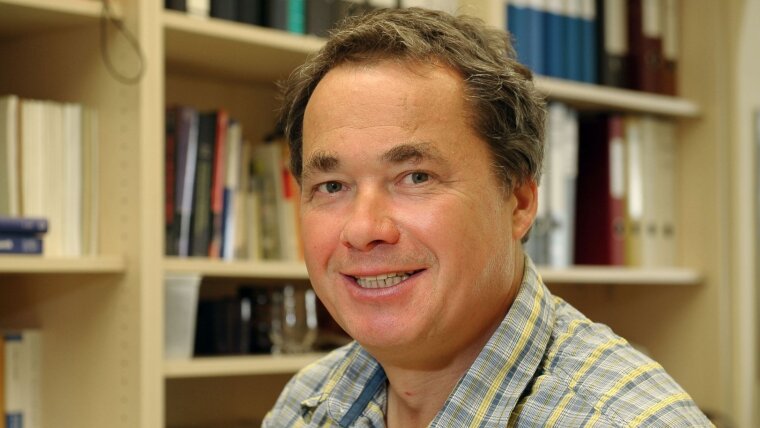
Prof. Dr. Stephan Fritzsche
Image: PrivateProf. Dr. Stephan FRITZSCHE
Email: s.fritzsche@gsi.de
Phone: +49 3641-9-47606
Professor Fritzsche is a board member at the Helmholtz Institute Jena and head of the Theory Group at this institute. Prof. Fritzsche also serves as Principal Editor for Computer Physics Communications, a peer-reviewed international journal with focus on the numerical analysis and software design in physics and physical chemistry.
With the advent of new and tunable light sources, the electron dynamics of atoms and ions can nowadays be studied in great detail, from the femtosecond down to the attosecond scale. For instance, the irradiation of matter with intense FEL pulses hereby results in a large number of induced ionization, auto-ionization and recombination processes. To explore these - explicitly time-dependent - processes, we apply the density matrix theory to the emission and capture of electrons, and which combines analytical model with often extensive computations in order to achieve a quantitative (and predictive) understanding of light-matter interactions in strong fields. Beside of such atomic processes, we also investigate twisted particle beams carrying quantized angular momentum and the properties of highly-charged ions for their application in astro, nuclear and plasma physics.
Research Area
Prof. Fritzsche’s research interests deal with the structure and dynamics of finite quantum systems for applications in atomic and optical physics. Current research topics are:
- Multi-photon ionization dynamics in intense FEL radiation
- Excitation, auto-ionization and decay cascades of atomic and molecular systems
- Light-matter interactions and light scattering in strong Coulomb fields
- Particle beams carrying quantized orbital angular momentum
- design and implementation of community tools for atomic, astro and plasma physics
Teaching Field
Prof. Fritzsche´s teaching has as its focus the behavior of correlated quantum systems and includes courses in:
- Atomic structure and collision theory
- Light-matter interactions in strong and short pulses
- Computational quantum physics
Research Methods
Various concepts and theoretical techniques are applied by Prof. Fritzsche's group for studying the structure and light-matter coupling of finite quantum systems, including:
- Relativistic atomic & many-body theory
- Numerical simulation techniques and code development
- Time-independent and time-dependent density matrix theory
- Computer-algebraic techniques
- Concepts and protocols from quantum information theory and quantum state estimation
Recent Research Results
In recent years, the atomic density matrix theory has been successfully applied to model the excitation, ionization and recombination dynamics of neutrals and multiple-charged ions, and with applications in nuclear, atomic and plasma physics as well as x-ray science. Emphasis has been especially placed on the quantum-electrodynamical (QED) treatment of the emitted photons and electrons in order to explore the relativistic light-matter coupling in strong Coulomb fields. It was shown, for example, that magnetic contributions of the radiation field often lead to strong modifications in the emission and scattering of photons by atoms and highly-charged ions [1, 2]. Moreover, many of these photon-atom interactions are enhanced by resonances due to the excitation of innershell electrons [3-5].
Apart from the interaction of atoms with plane-wave photons and electrons, recent interest was placed upon the role of the orbital angular momentum in atomic processes. Today, twisted beams of photons and electrons can be generated with energies of up to keV and with quite high topological charges. In our group, we explore the interaction of such beams at both, medium and strong intensities, and for which nonlinear interactions become prominent [6]. With the well-known JAC toolbox [7], moreover, a new atomic code is presently established for the computation of (many-electron) interaction amplitudes, properties as well as a large number of excitation and decay processes for open-shell atoms and ions across the whole periodic table.
[1] Volotka et al., Rhys. Rev. A 100, 010502 [R] (2019).
[2] Zaytsev et al., Phys. Rev. Lett. 123, 093401 (2019).
[3] Hofbrucker et al., Phys. Rev. Lett. 121, 053401 (2018).
[4] Hofbrucker et al., Sci. Reports 10, 3617 (2020).
[5] Perry-Sassmannshausen et al., Phys. Rev. Lett. 124, 083203 (2020).
[6] Böning et al., Phys. Rev. A 99, 053404 (2019).
[7] Fritzsche, Comp. Phys. Commun. 240, 1 (2019).
link to the Relativistic Quantum Dynamics GroupExternal link
